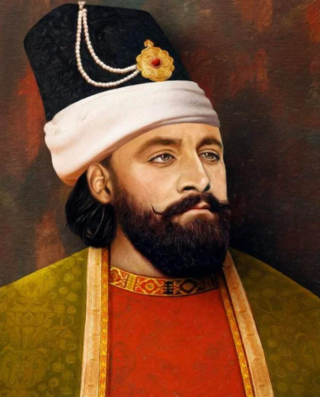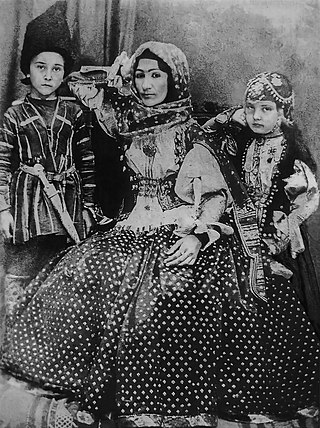Related Research Articles

The Karabakh Khanate was a khanate under Iranian and later Russian suzerainty, which controlled the historical region of Karabakh, now divided between modern-day Armenia and Azerbaijan. In terms of structure, the Karabakh Khanate was a miniature version of Iranian kingship. The administrative and literary language in Karabakh until the end of the 19th century was Persian, with Arabic being used only for religious studies, despite the fact that most of the Muslims in the region spoke a Turkic dialect.

The Ganja Khanate was a khanate under Iranian suzerainty, which controlled the town of Ganja and its surroundings, now located in present-day Azerbaijan.

The Shaki Khanate was a khanate under Iranian and later Russian suzerainty, which controlled the town of Shaki and its surroundings, now located in present-day Azerbaijan.
Ibrahim Khalil Khan Javanshir was the second khan of the Karabakh Khanate from the Javanshir family. He was the son and successor of Panah-Ali khan Javanshir.

Panah Ali Khan Javanshir was the founder and first ruler of the Karabakh Khanate under Persian suzerainty.
Javad Khan ; c. 1748 – 1804) was a member of Ziyadoghlu Qajar, a clan of the Qajar tribe, as well as the sixth and the last khan of the Ganja Khanate from 1786 to 1804 before it was lost to Russia.

The Javanshirs are a Turkic clan from Karabakh, who are a branch of the Oghuz Turks. Between 1748 and 1822, members of the Javanshir clan functioned as the head of the Karabakh Khanate.
Haji Chalabi Khan, was a statesman, warlord, ruler and founder of Shaki Khanate.

Agha Baji Javanshir was an Iranian poet and public speaker, who was the twelfth wife of Fath-Ali Shah Qajar, the Qajar shah (king) of Iran. She was the daughter of Ibrahim Khalil Khan, the governor of the Karabakh Khanate.
Mehdi Qoli Khan Javanshir was the last Khan of the Karabakh Khanate, functioning as its head from 1806 to 1822. His only known issue was Khurshidbanu Natavan, a famous Azerbaijani poet.
Muhammad Hasan Khan (1742–1778) was the second Khan of Ganja from 1768 to 1780 from the Ziyadoglu branch of the Qajar clan who ruled the Beylerbeylik of Karabakh as hereditary governors.
Mirza Muhammad Khan I was the founding Khan of the Baku Khanate. He was a descendant of the Iranian garrison commander of Baku of 1723.

Shamshadil was a sultanate in the South Caucasus established in 1747. It was located in what is now northeastern Armenia and northwestern Azerbaijan.
Abu'l-Fath Khan Javanshir was an Iranian commander who participated in the Russo-Iranian War of 1804–1813. He was the son of Ibrahim Khalil Khan, a member of the Javanshir tribe and governor of the Karabakh Khanate in the South Caucasus.
Mirza Jamal Javanshir was a secretary and historian under the Karabakh Khanate and later the Russian Empire. He is principally known as the author of the Persian-language historical chronicle Tarikh-e Qarabagh.
Melik Shahnazar II was the melik of Varanda, one of the five Melikdoms of Karabakh, in the 18th century. He is a controversial figure in Armenian history, whose actions contributed significantly to the demise of the Armenian Melikdoms of Artsakh.
Fazl Ali-bey Javanshir was a member of the Karabakh Javanshir tribe, the elder brother of Panahali Khan Javanshir. He worked as viceroy (naib) and master of ceremonies of Nadir Shah Afshar.
Muhammad Khan, Mammad Khan or Muhammad II of Ganja (1738–1780) was the third Khan of Ganja from 1768 to 1780 from the Ziyadoglu branch of the Qajar clan who ruled the Beylerbeylik of Karabakh as hereditary governors.
Ziyadoghlu Qajar or Ziyadlu were a branch of the Qajar tribe that governed Safavid Karabakh from 1546–1554 to 1743, Astarabad in various times, Ganja Khanate from 1747 to 1805. Some authors suggested that, Qovanlu branch of Qajars who ruled Iran from 1789 to 1925, which is currently better known as Qajar dynasty was a cadet-branch of Ziyadoghlu family.
Ughurlu Khan or Oghurlu Khan was a claimant to Khanate of Ganja and a member Ziyadoghlu Qajar, a clan of the Qajar tribe.
References
- ↑ Russian embassies to the Georgian kings, 1589-1605. Volume 1. W. E. D. Allen, Sergeĭ Alekseevich Belokurov, Anthony Mango. Farnham, Surrey, England: Ashgate. 2010. p. 72. ISBN 978-1-4094-3246-3. OCLC 759159970.
{{cite book}}: CS1 maint: others (link) - ↑ Tapper, Richard (1997). Frontier nomads of Iran : a political and social history of the Shahsevan. New York, NY, USA: Cambridge University Press. pp. 114–115. ISBN 0-585-03973-9. OCLC 42854663.
- ↑ Bournoutian 2021, p. 251..
- ↑ Babayev 2003, p. 11.
- ↑ Emïn, Joseph (1792). Life and Adventures of Emin Joseph Emin, 1726-1809. Baptist mission Press. p. 348.
- ↑ Bournoutian 2021, p. 251.
- ↑ Babayev 2003, p. 12.
- ↑ Perry, John R. (2015-05-14). Karim Khan Zand: A History of Iran, 1747-1779. University of Chicago Press. p. 211. ISBN 978-0-226-66102-5.
- ↑ Babayev 2003, p. 15.
- ↑ Qarabaghi, Jamal Javanshir; Qarābāghī, Jamāl Javānshīr; Bournoutian, George A. (1994). A History of Qarabagh: An Annotated Translation of Mirza Jamal Javanshir Qarabaghi's Tarikh-e Qarabagh. Mazda Publishers. p. 73. ISBN 978-1-56859-011-0.
- ↑ Babayev 2003, p. 19.
- ↑ Babayev 2003, p. 21.
- ↑ Bournoutian 2021, p. 252.
- ↑ Akopyan, Alexander V (Autumn 2008). "Ganja Coins of Georgian Types, AH 1200–1205" (PDF). Journal of the Oriental Numismatic Society. 197 (Supplement: Caucasian Numismatics, Papers on the Coinage of Kartl-Kakheti (Eastern Georgia), 1744–1801): 47–52. Archived from the original (PDF) on 2013-12-11.
{{cite journal}}: CS1 maint: year (link) - ↑ Babayev 2003, p. 98.